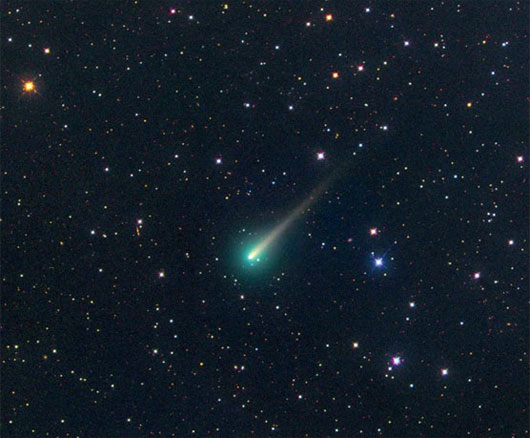Century comet directs the sun
A comet is straight towards the sun later this month and according to scientists, if it does not evaporate or fall apart, people on earth can see it with the naked eye in December, According to Reuters on 11/11.
>>>Comet 'century' approaches Earth
ISON Comet is expected to cross the sun with a distance of only about 1 million km on November 28.

The comet image of the century was recorded by NASA on November 8 - (photo: skyandtelescope.com)
Now scientists are not sure what will happen to ISON. It is possible that comets dubbed this century comet will explode when traveling at 377 km per second and be heated to 2,760 degrees Celsius, enough to evaporate not only ice on comets but also both stone and metal.
However, if the terrible temperature did not bury ISON's fate, the sun's gravity might split it into pieces. According to a recent calculation by scientists, ISON still survived and it will be a great opportunity to admire this spectacular natural phenomenon in the sky of the earth in December.
According to Reuters, the ISON comet was discovered by two amateur astronomers Vitali Nevski and Artyom Novichonok using a 40cm telescope of the International Science Optical System near Kislovodsk (Russia) in September 2012.
Like other comets, ISON is a mass of frozen gas that mixes rock dust forming near the solar system. It often moves in orbit affected by the gravity of the sun and planets in the solar system.
Noting the Hubble Space Telescope of the US Aeronautics and Space Agency (NASA), ISON has a core of about 4 km. When flying near the sun, the heat will cause the gas to freeze and evaporate and its tail lasts at least 92,000km.
On December 26, comet ISON will be about 64 million kilometers from Earth.
- Century comets
- The comet of the century will not light
- Comet detection is the brightest century
- Spectacular new image of the comet of the century
- Comet ISON only has dust left
- The ISON comet can be observed with the naked eye
- Video: Comet hit the sun
- Comet 'century' approaches the Earth
- Comet is brighter than the full moon visiting Earth in 2013
- Comet Lovejoy comet image from all over the world
- The comet 'graveyard' was discovered
- Comets of the century were destroyed when flying near the Sun.
 Van Allen's belt and evidence that the Apollo 11 mission to the Moon was myth
Van Allen's belt and evidence that the Apollo 11 mission to the Moon was myth The levels of civilization in the universe (Kardashev scale)
The levels of civilization in the universe (Kardashev scale) Today Mars, the sun and the Earth are aligned
Today Mars, the sun and the Earth are aligned The Amazon owner announced a secret plan to build a space base for thousands of people
The Amazon owner announced a secret plan to build a space base for thousands of people Comets of the century were destroyed when flying near the Sun.
Comets of the century were destroyed when flying near the Sun.  Comet ISON only has dust left
Comet ISON only has dust left  The ISON comet can be observed with the naked eye
The ISON comet can be observed with the naked eye  The comet of the century will not light
The comet of the century will not light  Comet 'century' approaches the Earth
Comet 'century' approaches the Earth  Spectacular new image of the comet of the century
Spectacular new image of the comet of the century 